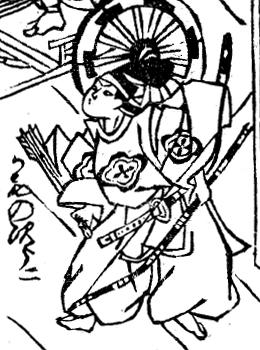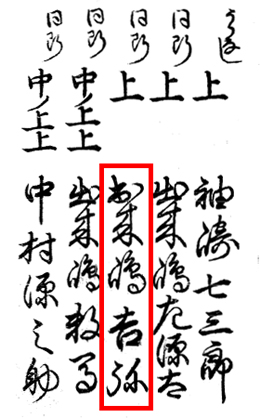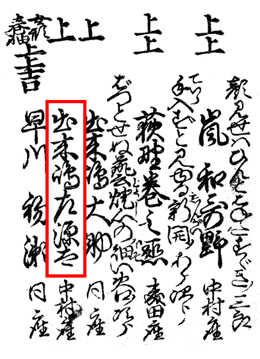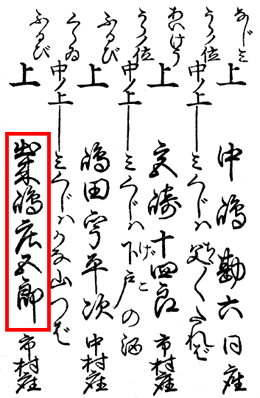| LESSER KNOWN ACTORS - DEKISHIMA |
| Dekishima Heihachi Dekishima Heihachi |
|
|
Dates of birth and death unknown. Disciple of Dekishima Sagenta, he received the name of Dekishima Heihachi and was recorded for the first time as performing as a wakashugata in the 11th lunar month of 1717 at the Moritaza in Murase Genzabur˘'s kaomise drama "H˘n˘ Taiheiki". He performed for a while in tabi shibai and went back to Edo in fall 1722 and played at the Nakamuraza the role of Sasano Tsuneharu in the kaomise drama "H˘nen Taiheiki". He appeared on stage for the last time in the 11th lunar month of 1735 at the Kawarasakiza the role of Kazusa no Gor˘ in the kaomise drama "Banzei Ikioi Izu Nikki". His rank in the 1736 Edo hy˘banki, tsuno katsura wakatachiyaku [1] section, was j˘-(shiro)j˘ (superior - (white) superior) [visual]. No record afterwards. |
|
 |
|
|
Dekishima Heihachi playing the role of Kamo no Jir˘ in the kaomise drama "Kankatsu Michinoku no Miyako", which was staged in the 11th lunar month of 1730 at the Moritaza |
|
| Dekishima Kichiya Dekishima Kichiya |
|
|
Date of birth unknown. He was recorded for the first time in a 1688 Edo hy˘banki. He was most likely a disciple of Dekishima Kozarashi I and, later, of Dekishima Kozarashi II [2]. His stage name was Dekishima Kichiya and he became a wakaonnagata. He played in the 11th lunar month of 1709 at the Moritaza the role of Minamoto no Yorinaga's sister Princess Haru [3] in the kaomise drama "Tametomo Furiwakegami", which welcomed in Edo the ďsaka actors Hisamatsu Tasanta and Iwai Tamanoe. He appeared on stage for the last time in the 11th lunar month of 1714, when he played at the Moritaza the role of Shiraito in the kaomise drama "Onna Ryűko Futatsu Gashira". His rank in the 1715 Edo hy˘banki, wakaonnagata section was j˘ (superior) [visual]. He died the 19th day of the 7th lunar month of 1715 [4]. He was the master of Dekishima Sagenta and Dekishima Sango I. |
|
 |
|
|
The name of Dekishima Kichiya in the 1715 Edo hy˘banki (the zone within the red box) |
|
| Dekishima Sagenta Dekishima Sagenta |
|
|
Dates of birth and death unknown. Disciple of Dekishima Kichiya, he received the stage name of Dekishima Sagenta. He was recorded for the first time in the 11th lunar month of 1709 as performing as a wakaonnagata at the Moritaza in the kaomise drama "Tametomo Furiwakegami", which welcomed in Edo the ďsaka actors Hisamatsu Tasanta and Iwai Tamanoe. He appeared on stage for the last time in the 1st lunar month of 1724, in Edo at the Nakamuraza, where he performed in the new year drama "Matsu Kazari Kamakura Biraki". His rank in the 1724 Edo hy˘banki [5], wakaonnagata section was j˘ (superior) [visual]. No record afterwards. He was the master of Dekishima Heihachi. |
|
 |
|
|
The name of Dekishima Sagenta in the 1724 Edo hy˘banki (the zone within the red box) |
|
| Dekishima Sh˘gor˘ Dekishima Sh˘gor˘ |
|
|
Date of birth unknown. He was recorded for the first time in a 1693 Edo hy˘banki. Was he a disciple of Dekishima Kozarashi II? [6]. He became tachiyaku and performed in the 11th lunar month of 1695 at the Yamamuraza in the kaomise drama "Kaomise Jűnidan". He became t˘dori at the Ichimuraza in 1713. He played in the 11th lunar month of 1715 at the Ichimuraza the role of Honma Gekizaemon in the kaomise drama "Banzei Onna Hachinoki". His rank in the 1716 Edo hy˘banki [7], tachiyaku section was j˘ (superior) [visual]. He died the 19th day of the 5th lunar month of 1716 [8]. |
|
 |
|
|
The name of Dekishima Sh˘gor˘ in the 1715 Edo hy˘banki (the zone within the red box) |
|
|
|
|
|
[1] Literally the horned wig (tsuno katsura) young male actors. [2] Dekishima Kichiya was not recorded on the Dekishima family tree in Nojima Jusabur˘'s book "Kabuki Jinmei Jiten" but he performed mainly in Edo at the Moritaza, which was the Dekishima theater. [3] Minamoto no Yorinaga was played by Takahashi Motojir˘. [4] The 19th day of the 7th lunar month of the 5th year of the Sh˘toku era was the 17th of August 1715 in the western calendar. [5] He had the same ranking in the two 1724 hy˘banki, the one published after the kaomise in the 1st lunar month of 1724 and the one published after the new year drama in the 3rd lunar month of 1724. [6] No answer to this question so far. [7] This hy˘banki was published in the 4th lunar month of 1716. [8] The 19th day of the 5th lunar month of the 6th year of the Sh˘toku era was the 8th of July 1716 in the western calendar. |
|
|
|
| Contact | Main | Top | Updates | Actors | Plays | Playwrights | Programs | Links | FAQ | Glossary | Chronology | Illustrations | Prints | Characters | Derivatives | Theaters | Coming soon | News |